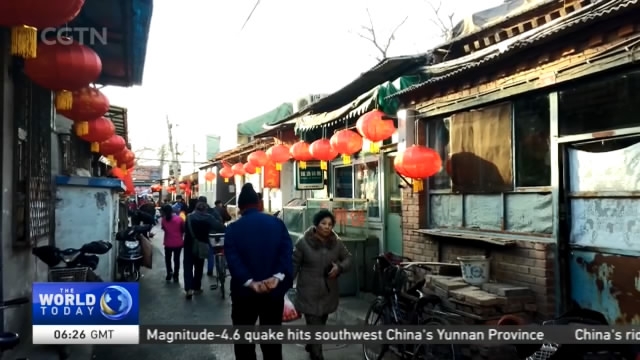
14:47, 04-Jan-2018
Historic Hutongs: Beijing carries out face lifts to more hutongs

Dashilanr, one of Beijing's most famous old hutong districts, is celebrating the tenth anniversary this year of its complete renovation. And now, the Chinese capital wants more hutongs to go under similar rejuvenation. As our reporter Xu Xinchen finds out that while efforts to rejuvenate Beijing's hutongs and their culture have been widely welcomed, the process takes time and thorough planning.
This is Dashilanr, one of the most famous hutong districts in Beijing. However, it did not look like this until after an investment of over 20 million yuan for renovations ten years ago.
XU XINCHEN BEIJING "Dashilanr has become a popular tourist spot as it has 18 intangible cultural heritage projects and at the same time, is also home to some 50,000 people. Beijing now wants to bring this sort of vibe to more hutongs by preserving the cultural heritage and improving the living standard for the residents. Similar efforts like what was done here at Dashilanr are also being made at other hutongs."
Elderly resident, Yuan Jisheng, has for over three decades been living in Dazhiqiao hutong -- a residential area a few blocks away from Dashilanr. Dazhiqiao is home to some 400 residents and underwent renovations just last year.
YUAN JISHENG DAZHIQIAO HUTONG RESIDENT "Before the renovation, the street was crowded with food vendors. There was oil and smoke everywhere. People fought and quarrelled on the street. We didn't even go out much."
It took over a year to clean up the 186-meter-long Dazhiqiao hutong -- tearing down unauthorized store fronts, refurbishing outer walls, and wiring electricity from above into the ground. And the district plans to roll out similar renovations to other hutongs.
GAO BO DAZHIQIAO HUTONG MANAGEMENT TEAM "Led by the renovation of Dazhiqiao, plans to renovate another six hutongs in the neigborhood were initiated in April 2017."
Local authorities are still discussing how they should further use renovated space if they should promote the region's cultural heritage or develop it into a commercial street similar to Dashilanr. But it might not be that easy.
ZHU JIAN, DEPUTY DIRECTOR DASHILANR NEIGHBORHOOD AND CITY MANAGEMENT "While Dashilanr is still mainly a residential area, the commercial area has historically been separated from the residential side."
Li Yongsheng is the owner of a local opera house in Dashilanr. It is built on the land where a two-century-old theater was, before being demolished twenty years ago. Li's company decided to bring the theater back in 2013.
LI YONGSHENG, PRESIDENT SANQINGYUAN "Beijing hutong culture has its own special characteristics. Reviving hutongs should still be rooted in protecting hutong culture, however, I think, capital involvement is needed to create more sustainable development. However, capital needs returns. So in that sense, we need to be careful and not seek instant success and quick returns."
Dashilanr now attracts some 60,000 visitors daily and generates over 500 million yuan annually. But residents in Dazhiqiao are looking for something different.
YUAN JISHENG DAZHIQIAO HUTONG RESIDENT "Now, what we need is cleaning up inside -- such as removing unauthorized construction within the residential compounds."
There are over 6,000 different hutongs in Beijing -- home to huge reserves of the city's cultural relics as well as millions of people.

SITEMAP
Copyright © 2018 CGTN. Beijing ICP prepared NO.16065310-3
Copyright © 2018 CGTN. Beijing ICP prepared NO.16065310-3